Classical vs. Modern Organization Theories: Employee Behavior Report
VerifiedAdded on 2021/04/21
|13
|2383
|25
Report
AI Summary
This report provides a comprehensive overview of organization and employee behavior, delving into both classical and modern organizational theories. It begins by defining and exploring the key principles of classical theory, including scientific management, bureaucratic approaches, and administrative theory, as well as the significance of social identity within an organization. The report then transitions to modern organizational theories, such as systems, socio-technical, and situational approaches, highlighting their emphasis on interconnected systems and human behavior. A key aspect of the report involves a detailed contrast between these two theoretical frameworks, emphasizing their differing perspectives on organizational structure and environment. Furthermore, the report discusses the practical applications of these theories, particularly in leadership and employee engagement, and identifies a significant literature gap concerning the social application of modern organizational theories. Through this analysis, the report offers insights into how these theories influence managerial practices, employee motivation, and overall organizational effectiveness.
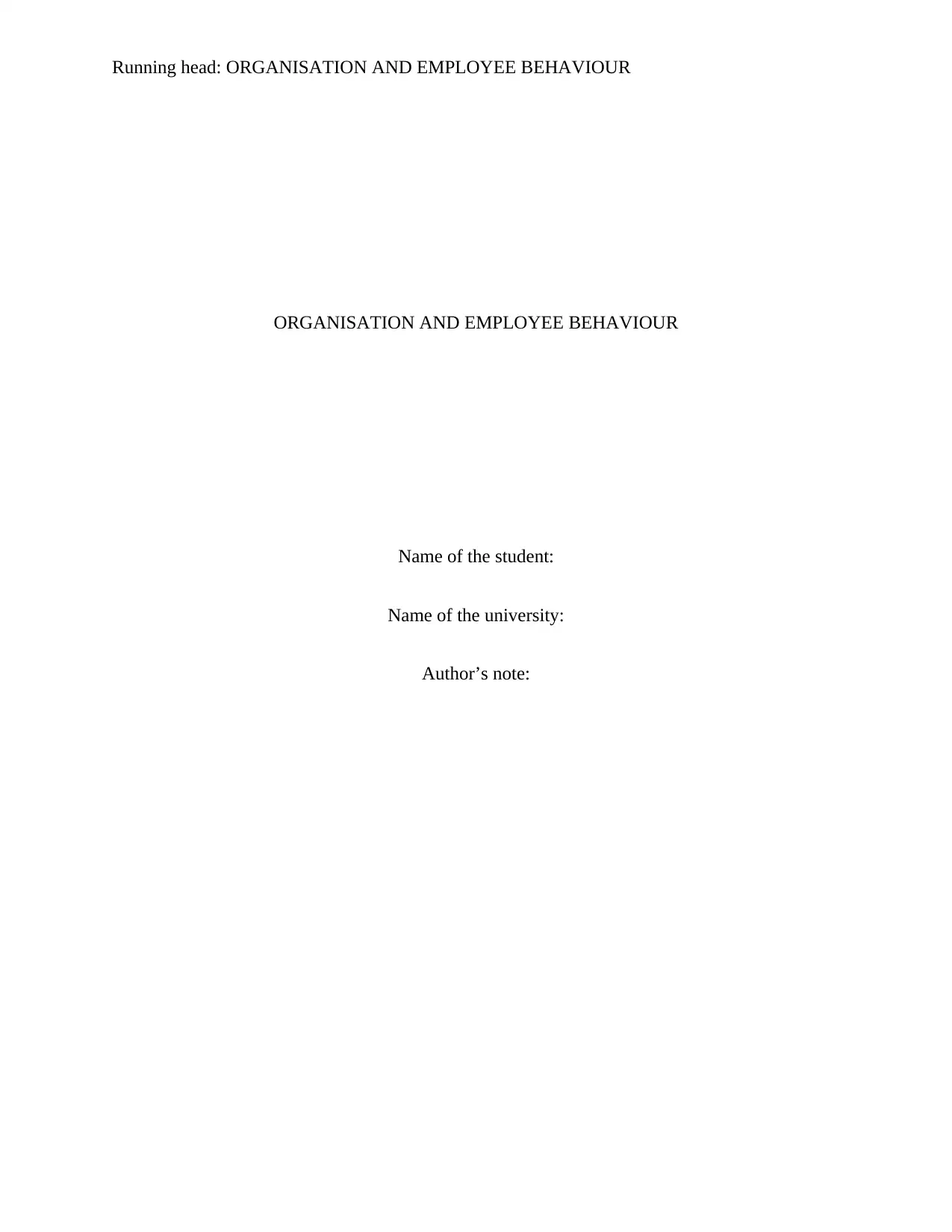
Running head: ORGANISATION AND EMPLOYEE BEHAVIOUR
ORGANISATION AND EMPLOYEE BEHAVIOUR
Name of the student:
Name of the university:
Author’s note:
ORGANISATION AND EMPLOYEE BEHAVIOUR
Name of the student:
Name of the university:
Author’s note:
Paraphrase This Document
Need a fresh take? Get an instant paraphrase of this document with our AI Paraphraser
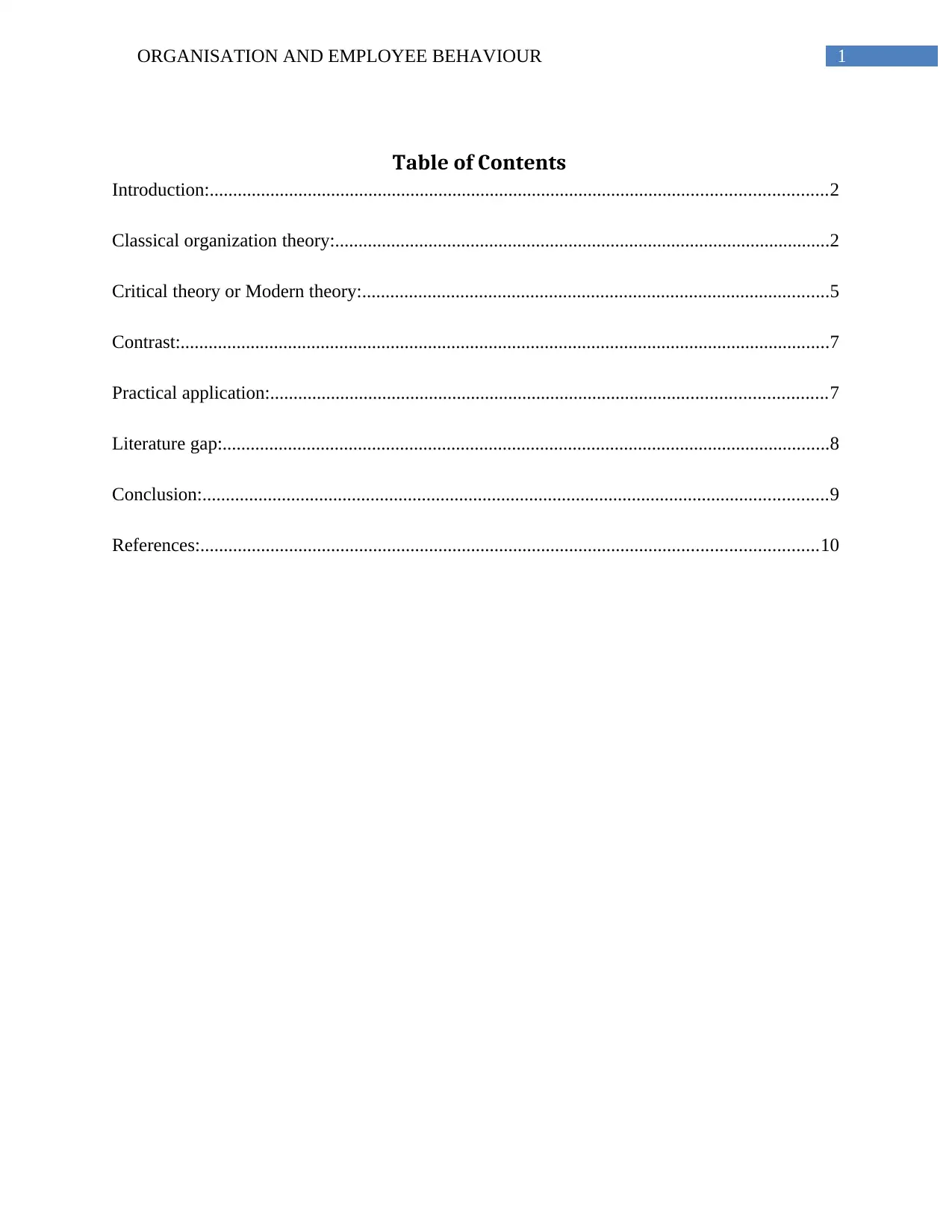
1ORGANISATION AND EMPLOYEE BEHAVIOUR
Table of Contents
Introduction:....................................................................................................................................2
Classical organization theory:..........................................................................................................2
Critical theory or Modern theory:....................................................................................................5
Contrast:...........................................................................................................................................7
Practical application:.......................................................................................................................7
Literature gap:..................................................................................................................................8
Conclusion:......................................................................................................................................9
References:....................................................................................................................................10
Table of Contents
Introduction:....................................................................................................................................2
Classical organization theory:..........................................................................................................2
Critical theory or Modern theory:....................................................................................................5
Contrast:...........................................................................................................................................7
Practical application:.......................................................................................................................7
Literature gap:..................................................................................................................................8
Conclusion:......................................................................................................................................9
References:....................................................................................................................................10
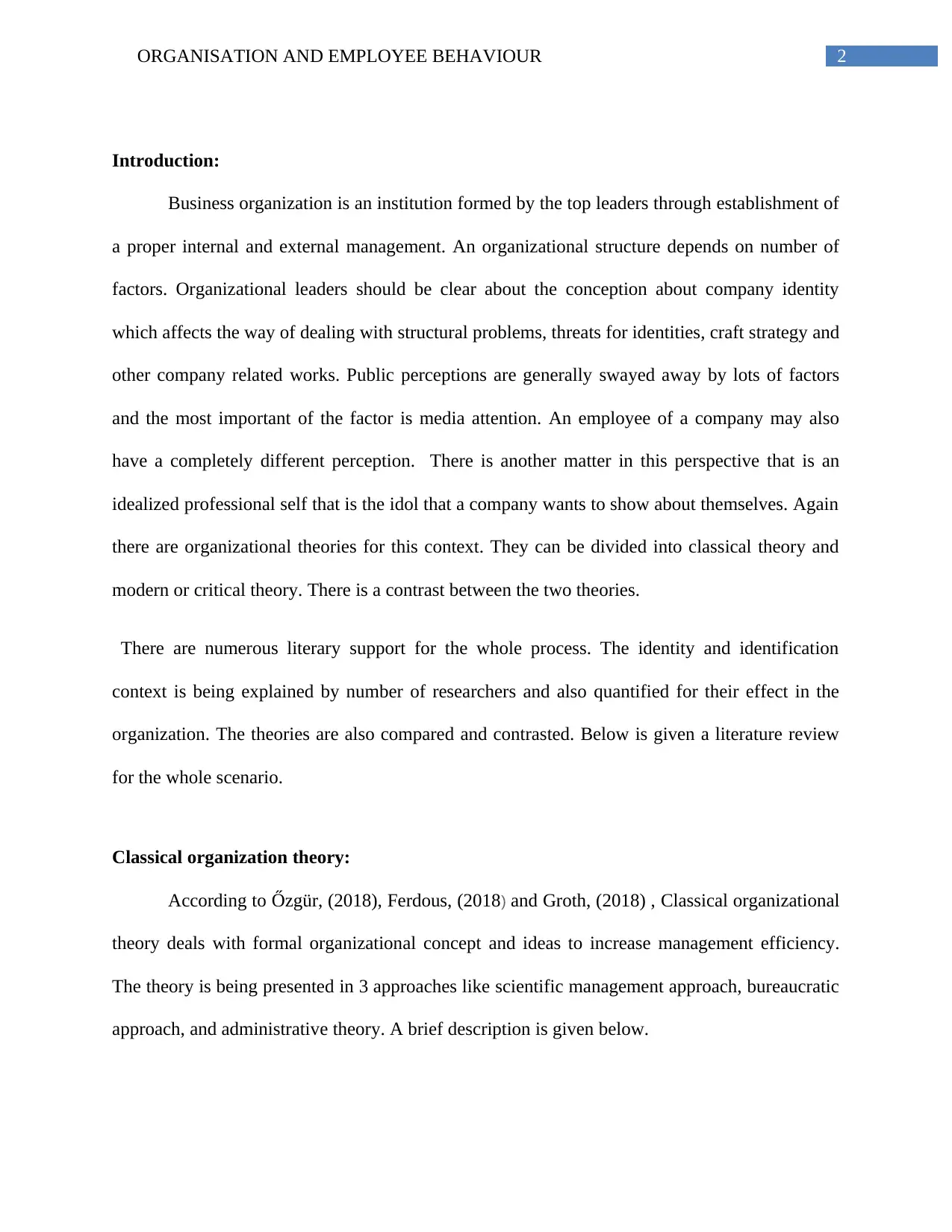
2ORGANISATION AND EMPLOYEE BEHAVIOUR
Introduction:
Business organization is an institution formed by the top leaders through establishment of
a proper internal and external management. An organizational structure depends on number of
factors. Organizational leaders should be clear about the conception about company identity
which affects the way of dealing with structural problems, threats for identities, craft strategy and
other company related works. Public perceptions are generally swayed away by lots of factors
and the most important of the factor is media attention. An employee of a company may also
have a completely different perception. There is another matter in this perspective that is an
idealized professional self that is the idol that a company wants to show about themselves. Again
there are organizational theories for this context. They can be divided into classical theory and
modern or critical theory. There is a contrast between the two theories.
There are numerous literary support for the whole process. The identity and identification
context is being explained by number of researchers and also quantified for their effect in the
organization. The theories are also compared and contrasted. Below is given a literature review
for the whole scenario.
Classical organization theory:
According to Őzgür, (2018), Ferdous, (2018) and Groth, (2018) , Classical organizational
theory deals with formal organizational concept and ideas to increase management efficiency.
The theory is being presented in 3 approaches like scientific management approach, bureaucratic
approach, and administrative theory. A brief description is given below.
Introduction:
Business organization is an institution formed by the top leaders through establishment of
a proper internal and external management. An organizational structure depends on number of
factors. Organizational leaders should be clear about the conception about company identity
which affects the way of dealing with structural problems, threats for identities, craft strategy and
other company related works. Public perceptions are generally swayed away by lots of factors
and the most important of the factor is media attention. An employee of a company may also
have a completely different perception. There is another matter in this perspective that is an
idealized professional self that is the idol that a company wants to show about themselves. Again
there are organizational theories for this context. They can be divided into classical theory and
modern or critical theory. There is a contrast between the two theories.
There are numerous literary support for the whole process. The identity and identification
context is being explained by number of researchers and also quantified for their effect in the
organization. The theories are also compared and contrasted. Below is given a literature review
for the whole scenario.
Classical organization theory:
According to Őzgür, (2018), Ferdous, (2018) and Groth, (2018) , Classical organizational
theory deals with formal organizational concept and ideas to increase management efficiency.
The theory is being presented in 3 approaches like scientific management approach, bureaucratic
approach, and administrative theory. A brief description is given below.
⊘ This is a preview!⊘
Do you want full access?
Subscribe today to unlock all pages.

Trusted by 1+ million students worldwide
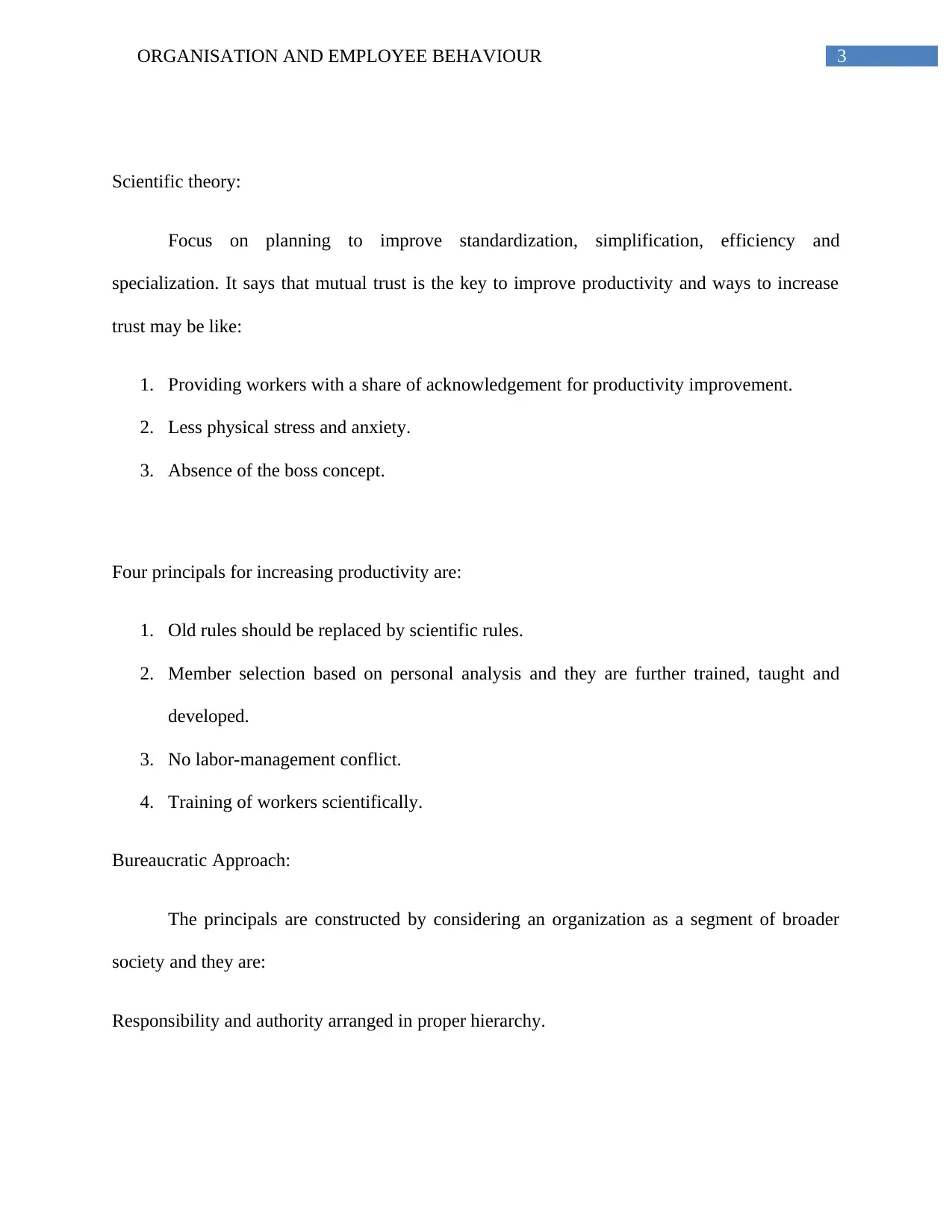
3ORGANISATION AND EMPLOYEE BEHAVIOUR
Scientific theory:
Focus on planning to improve standardization, simplification, efficiency and
specialization. It says that mutual trust is the key to improve productivity and ways to increase
trust may be like:
1. Providing workers with a share of acknowledgement for productivity improvement.
2. Less physical stress and anxiety.
3. Absence of the boss concept.
Four principals for increasing productivity are:
1. Old rules should be replaced by scientific rules.
2. Member selection based on personal analysis and they are further trained, taught and
developed.
3. No labor-management conflict.
4. Training of workers scientifically.
Bureaucratic Approach:
The principals are constructed by considering an organization as a segment of broader
society and they are:
Responsibility and authority arranged in proper hierarchy.
Scientific theory:
Focus on planning to improve standardization, simplification, efficiency and
specialization. It says that mutual trust is the key to improve productivity and ways to increase
trust may be like:
1. Providing workers with a share of acknowledgement for productivity improvement.
2. Less physical stress and anxiety.
3. Absence of the boss concept.
Four principals for increasing productivity are:
1. Old rules should be replaced by scientific rules.
2. Member selection based on personal analysis and they are further trained, taught and
developed.
3. No labor-management conflict.
4. Training of workers scientifically.
Bureaucratic Approach:
The principals are constructed by considering an organization as a segment of broader
society and they are:
Responsibility and authority arranged in proper hierarchy.
Paraphrase This Document
Need a fresh take? Get an instant paraphrase of this document with our AI Paraphraser
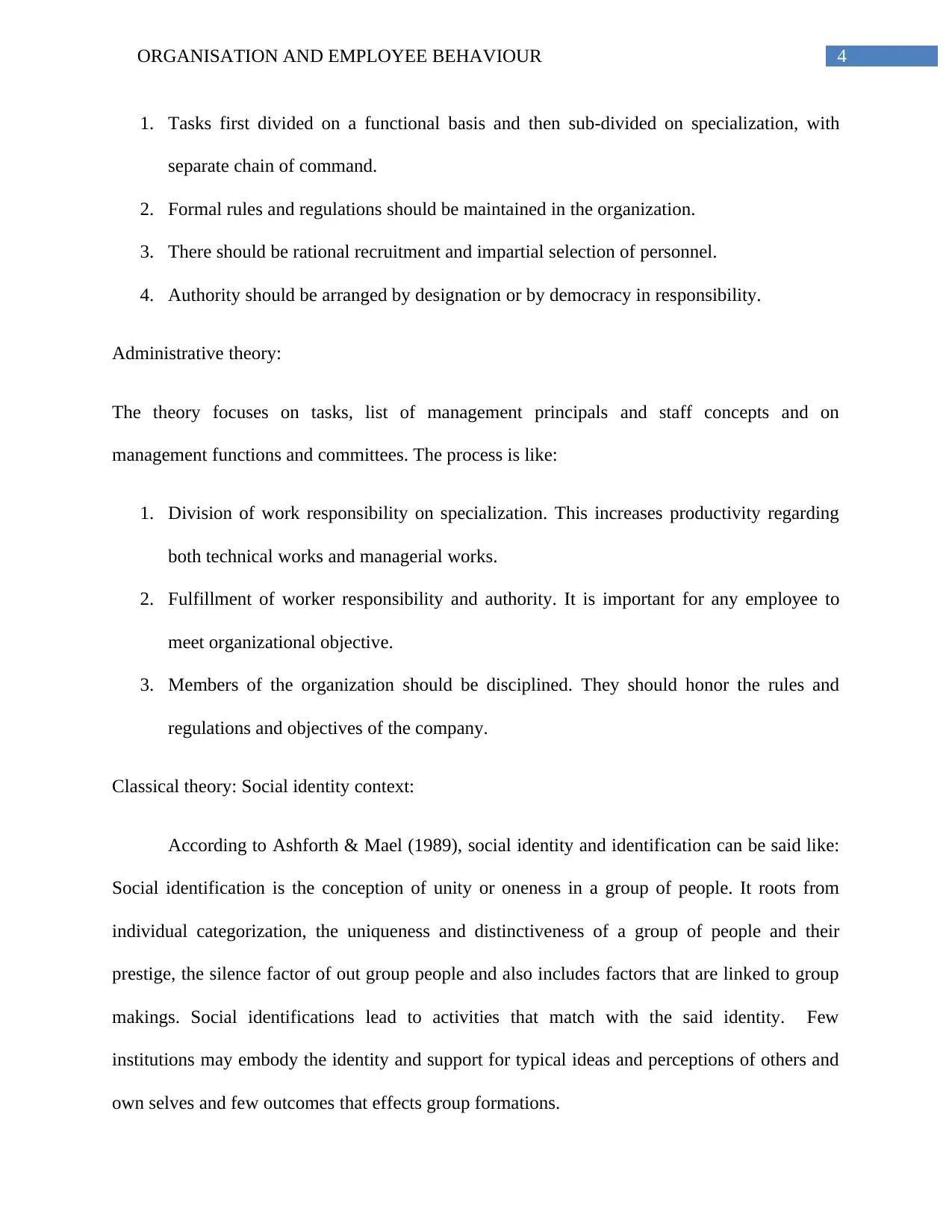
4ORGANISATION AND EMPLOYEE BEHAVIOUR
1. Tasks first divided on a functional basis and then sub-divided on specialization, with
separate chain of command.
2. Formal rules and regulations should be maintained in the organization.
3. There should be rational recruitment and impartial selection of personnel.
4. Authority should be arranged by designation or by democracy in responsibility.
Administrative theory:
The theory focuses on tasks, list of management principals and staff concepts and on
management functions and committees. The process is like:
1. Division of work responsibility on specialization. This increases productivity regarding
both technical works and managerial works.
2. Fulfillment of worker responsibility and authority. It is important for any employee to
meet organizational objective.
3. Members of the organization should be disciplined. They should honor the rules and
regulations and objectives of the company.
Classical theory: Social identity context:
According to Ashforth & Mael (1989), social identity and identification can be said like:
Social identification is the conception of unity or oneness in a group of people. It roots from
individual categorization, the uniqueness and distinctiveness of a group of people and their
prestige, the silence factor of out group people and also includes factors that are linked to group
makings. Social identifications lead to activities that match with the said identity. Few
institutions may embody the identity and support for typical ideas and perceptions of others and
own selves and few outcomes that effects group formations.
1. Tasks first divided on a functional basis and then sub-divided on specialization, with
separate chain of command.
2. Formal rules and regulations should be maintained in the organization.
3. There should be rational recruitment and impartial selection of personnel.
4. Authority should be arranged by designation or by democracy in responsibility.
Administrative theory:
The theory focuses on tasks, list of management principals and staff concepts and on
management functions and committees. The process is like:
1. Division of work responsibility on specialization. This increases productivity regarding
both technical works and managerial works.
2. Fulfillment of worker responsibility and authority. It is important for any employee to
meet organizational objective.
3. Members of the organization should be disciplined. They should honor the rules and
regulations and objectives of the company.
Classical theory: Social identity context:
According to Ashforth & Mael (1989), social identity and identification can be said like:
Social identification is the conception of unity or oneness in a group of people. It roots from
individual categorization, the uniqueness and distinctiveness of a group of people and their
prestige, the silence factor of out group people and also includes factors that are linked to group
makings. Social identifications lead to activities that match with the said identity. Few
institutions may embody the identity and support for typical ideas and perceptions of others and
own selves and few outcomes that effects group formations.
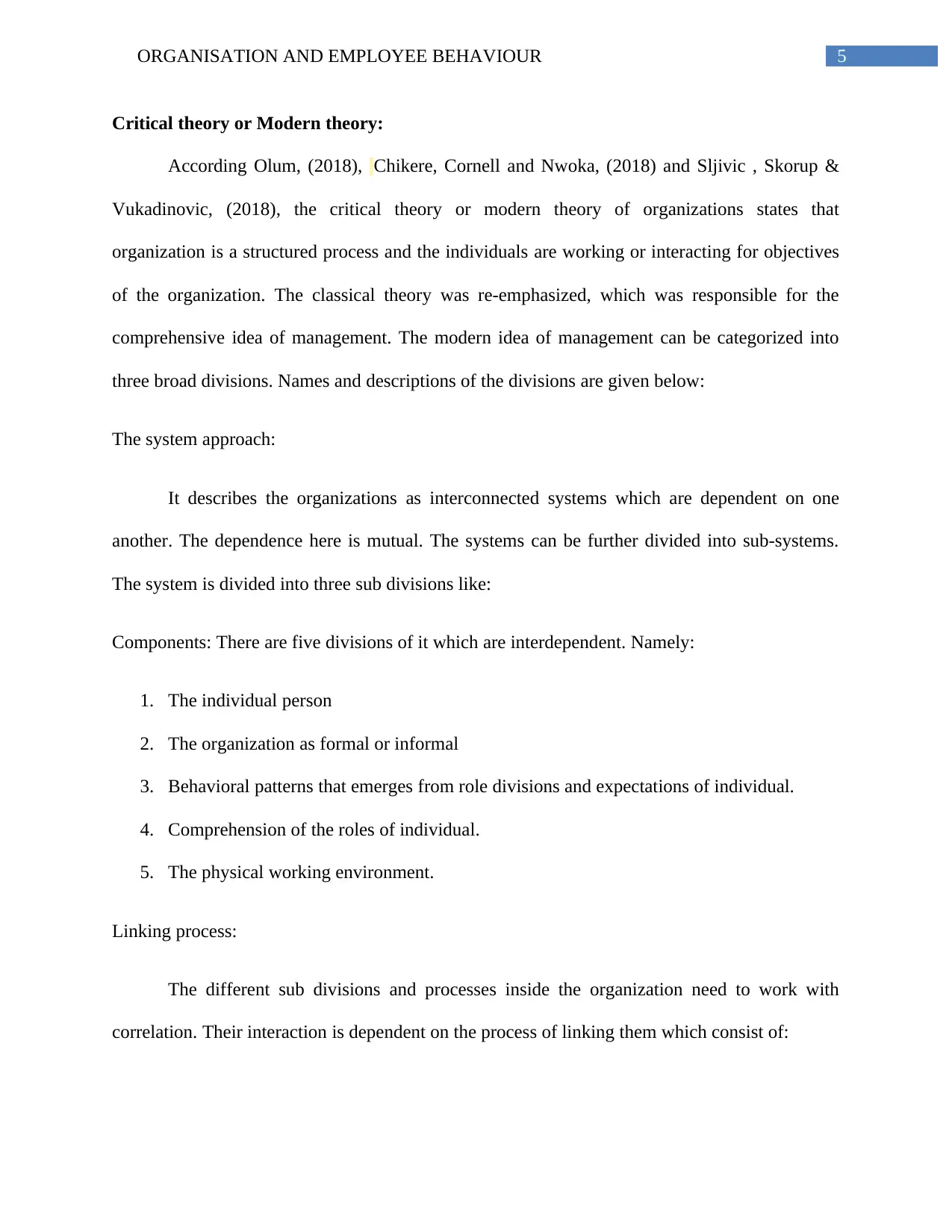
5ORGANISATION AND EMPLOYEE BEHAVIOUR
Critical theory or Modern theory:
According Olum, (2018), Chikere, Cornell and Nwoka, (2018) and Sljivic , Skorup &
Vukadinovic, (2018), the critical theory or modern theory of organizations states that
organization is a structured process and the individuals are working or interacting for objectives
of the organization. The classical theory was re-emphasized, which was responsible for the
comprehensive idea of management. The modern idea of management can be categorized into
three broad divisions. Names and descriptions of the divisions are given below:
The system approach:
It describes the organizations as interconnected systems which are dependent on one
another. The dependence here is mutual. The systems can be further divided into sub-systems.
The system is divided into three sub divisions like:
Components: There are five divisions of it which are interdependent. Namely:
1. The individual person
2. The organization as formal or informal
3. Behavioral patterns that emerges from role divisions and expectations of individual.
4. Comprehension of the roles of individual.
5. The physical working environment.
Linking process:
The different sub divisions and processes inside the organization need to work with
correlation. Their interaction is dependent on the process of linking them which consist of:
Critical theory or Modern theory:
According Olum, (2018), Chikere, Cornell and Nwoka, (2018) and Sljivic , Skorup &
Vukadinovic, (2018), the critical theory or modern theory of organizations states that
organization is a structured process and the individuals are working or interacting for objectives
of the organization. The classical theory was re-emphasized, which was responsible for the
comprehensive idea of management. The modern idea of management can be categorized into
three broad divisions. Names and descriptions of the divisions are given below:
The system approach:
It describes the organizations as interconnected systems which are dependent on one
another. The dependence here is mutual. The systems can be further divided into sub-systems.
The system is divided into three sub divisions like:
Components: There are five divisions of it which are interdependent. Namely:
1. The individual person
2. The organization as formal or informal
3. Behavioral patterns that emerges from role divisions and expectations of individual.
4. Comprehension of the roles of individual.
5. The physical working environment.
Linking process:
The different sub divisions and processes inside the organization need to work with
correlation. Their interaction is dependent on the process of linking them which consist of:
⊘ This is a preview!⊘
Do you want full access?
Subscribe today to unlock all pages.

Trusted by 1+ million students worldwide
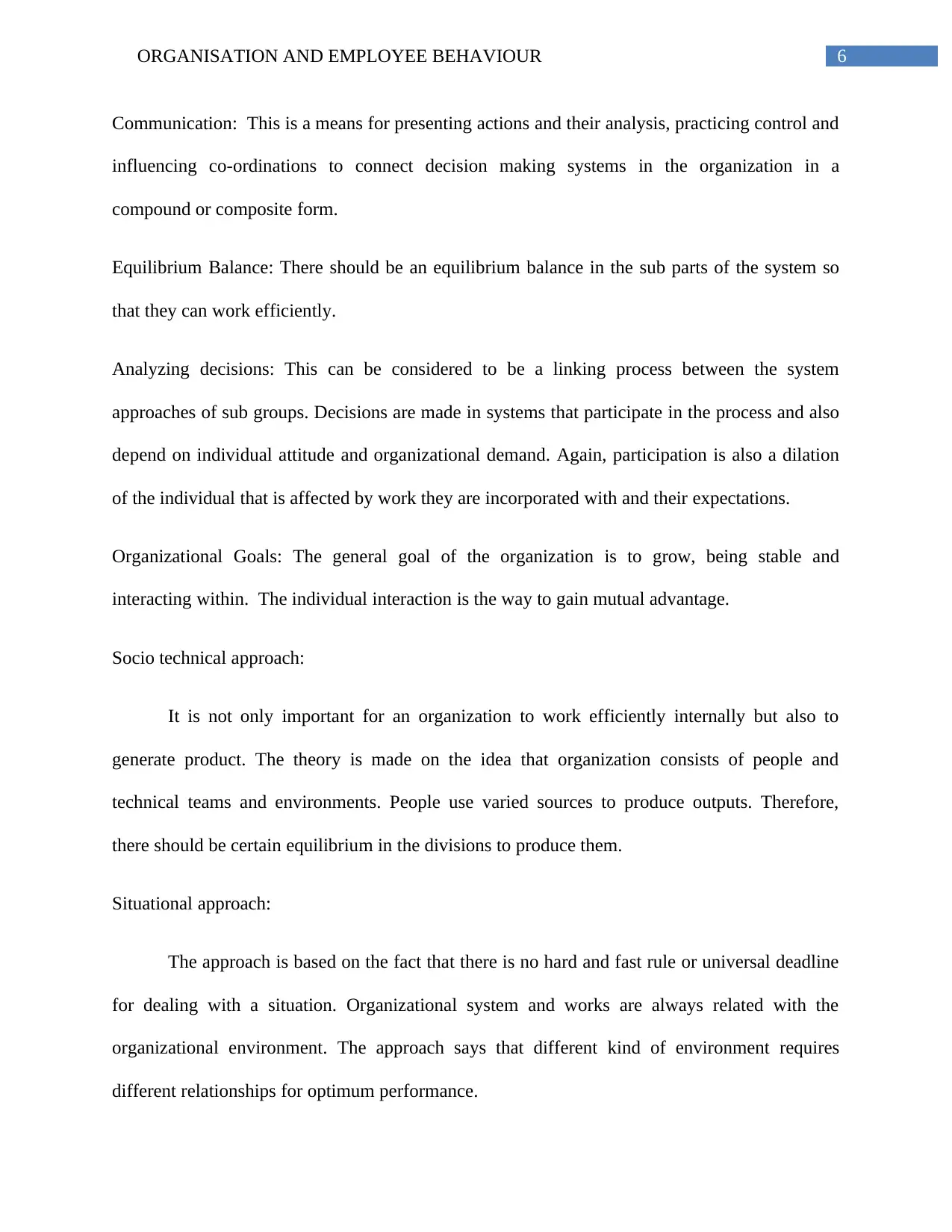
6ORGANISATION AND EMPLOYEE BEHAVIOUR
Communication: This is a means for presenting actions and their analysis, practicing control and
influencing co-ordinations to connect decision making systems in the organization in a
compound or composite form.
Equilibrium Balance: There should be an equilibrium balance in the sub parts of the system so
that they can work efficiently.
Analyzing decisions: This can be considered to be a linking process between the system
approaches of sub groups. Decisions are made in systems that participate in the process and also
depend on individual attitude and organizational demand. Again, participation is also a dilation
of the individual that is affected by work they are incorporated with and their expectations.
Organizational Goals: The general goal of the organization is to grow, being stable and
interacting within. The individual interaction is the way to gain mutual advantage.
Socio technical approach:
It is not only important for an organization to work efficiently internally but also to
generate product. The theory is made on the idea that organization consists of people and
technical teams and environments. People use varied sources to produce outputs. Therefore,
there should be certain equilibrium in the divisions to produce them.
Situational approach:
The approach is based on the fact that there is no hard and fast rule or universal deadline
for dealing with a situation. Organizational system and works are always related with the
organizational environment. The approach says that different kind of environment requires
different relationships for optimum performance.
Communication: This is a means for presenting actions and their analysis, practicing control and
influencing co-ordinations to connect decision making systems in the organization in a
compound or composite form.
Equilibrium Balance: There should be an equilibrium balance in the sub parts of the system so
that they can work efficiently.
Analyzing decisions: This can be considered to be a linking process between the system
approaches of sub groups. Decisions are made in systems that participate in the process and also
depend on individual attitude and organizational demand. Again, participation is also a dilation
of the individual that is affected by work they are incorporated with and their expectations.
Organizational Goals: The general goal of the organization is to grow, being stable and
interacting within. The individual interaction is the way to gain mutual advantage.
Socio technical approach:
It is not only important for an organization to work efficiently internally but also to
generate product. The theory is made on the idea that organization consists of people and
technical teams and environments. People use varied sources to produce outputs. Therefore,
there should be certain equilibrium in the divisions to produce them.
Situational approach:
The approach is based on the fact that there is no hard and fast rule or universal deadline
for dealing with a situation. Organizational system and works are always related with the
organizational environment. The approach says that different kind of environment requires
different relationships for optimum performance.
Paraphrase This Document
Need a fresh take? Get an instant paraphrase of this document with our AI Paraphraser
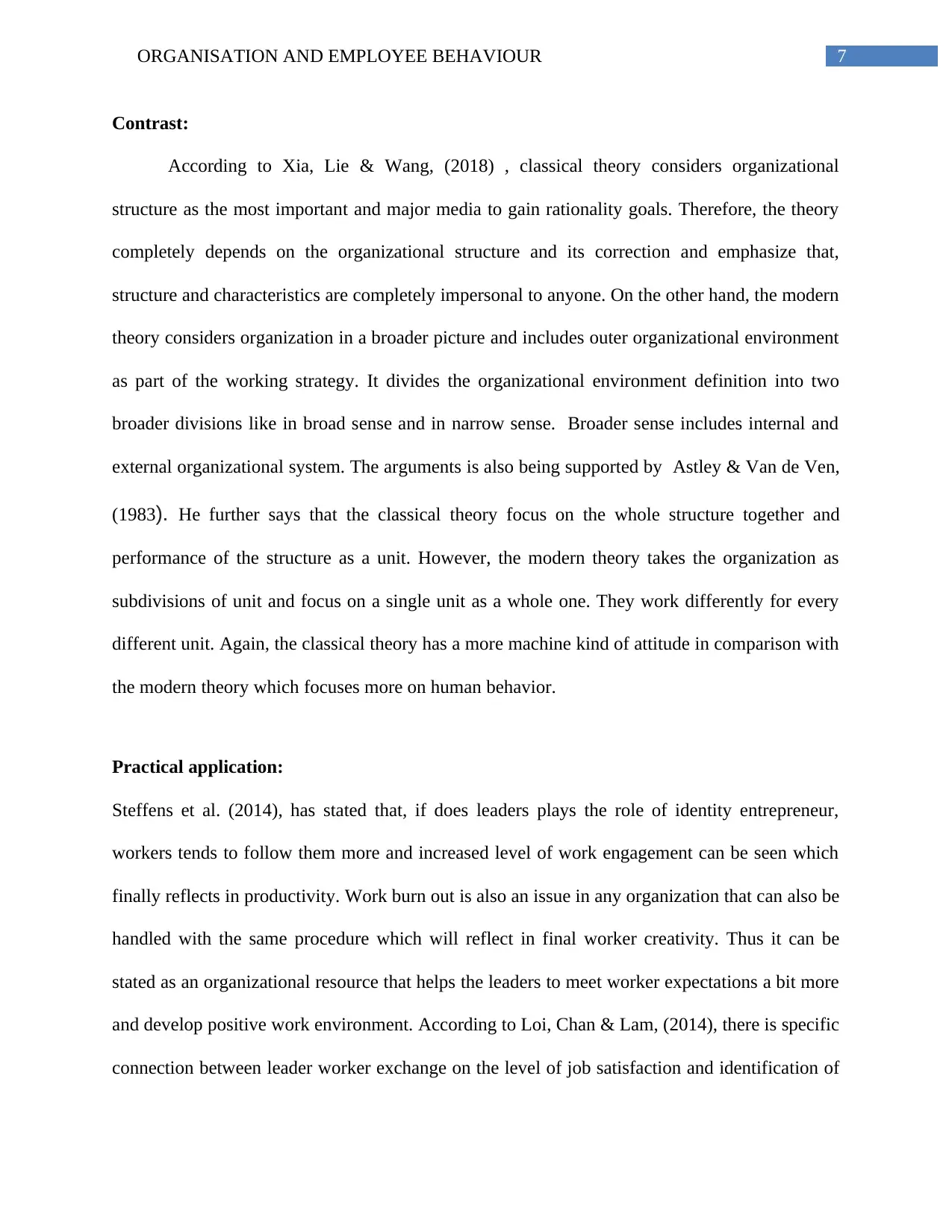
7ORGANISATION AND EMPLOYEE BEHAVIOUR
Contrast:
According to Xia, Lie & Wang, (2018) , classical theory considers organizational
structure as the most important and major media to gain rationality goals. Therefore, the theory
completely depends on the organizational structure and its correction and emphasize that,
structure and characteristics are completely impersonal to anyone. On the other hand, the modern
theory considers organization in a broader picture and includes outer organizational environment
as part of the working strategy. It divides the organizational environment definition into two
broader divisions like in broad sense and in narrow sense. Broader sense includes internal and
external organizational system. The arguments is also being supported by Astley & Van de Ven,
(1983). He further says that the classical theory focus on the whole structure together and
performance of the structure as a unit. However, the modern theory takes the organization as
subdivisions of unit and focus on a single unit as a whole one. They work differently for every
different unit. Again, the classical theory has a more machine kind of attitude in comparison with
the modern theory which focuses more on human behavior.
Practical application:
Steffens et al. (2014), has stated that, if does leaders plays the role of identity entrepreneur,
workers tends to follow them more and increased level of work engagement can be seen which
finally reflects in productivity. Work burn out is also an issue in any organization that can also be
handled with the same procedure which will reflect in final worker creativity. Thus it can be
stated as an organizational resource that helps the leaders to meet worker expectations a bit more
and develop positive work environment. According to Loi, Chan & Lam, (2014), there is specific
connection between leader worker exchange on the level of job satisfaction and identification of
Contrast:
According to Xia, Lie & Wang, (2018) , classical theory considers organizational
structure as the most important and major media to gain rationality goals. Therefore, the theory
completely depends on the organizational structure and its correction and emphasize that,
structure and characteristics are completely impersonal to anyone. On the other hand, the modern
theory considers organization in a broader picture and includes outer organizational environment
as part of the working strategy. It divides the organizational environment definition into two
broader divisions like in broad sense and in narrow sense. Broader sense includes internal and
external organizational system. The arguments is also being supported by Astley & Van de Ven,
(1983). He further says that the classical theory focus on the whole structure together and
performance of the structure as a unit. However, the modern theory takes the organization as
subdivisions of unit and focus on a single unit as a whole one. They work differently for every
different unit. Again, the classical theory has a more machine kind of attitude in comparison with
the modern theory which focuses more on human behavior.
Practical application:
Steffens et al. (2014), has stated that, if does leaders plays the role of identity entrepreneur,
workers tends to follow them more and increased level of work engagement can be seen which
finally reflects in productivity. Work burn out is also an issue in any organization that can also be
handled with the same procedure which will reflect in final worker creativity. Thus it can be
stated as an organizational resource that helps the leaders to meet worker expectations a bit more
and develop positive work environment. According to Loi, Chan & Lam, (2014), there is specific
connection between leader worker exchange on the level of job satisfaction and identification of
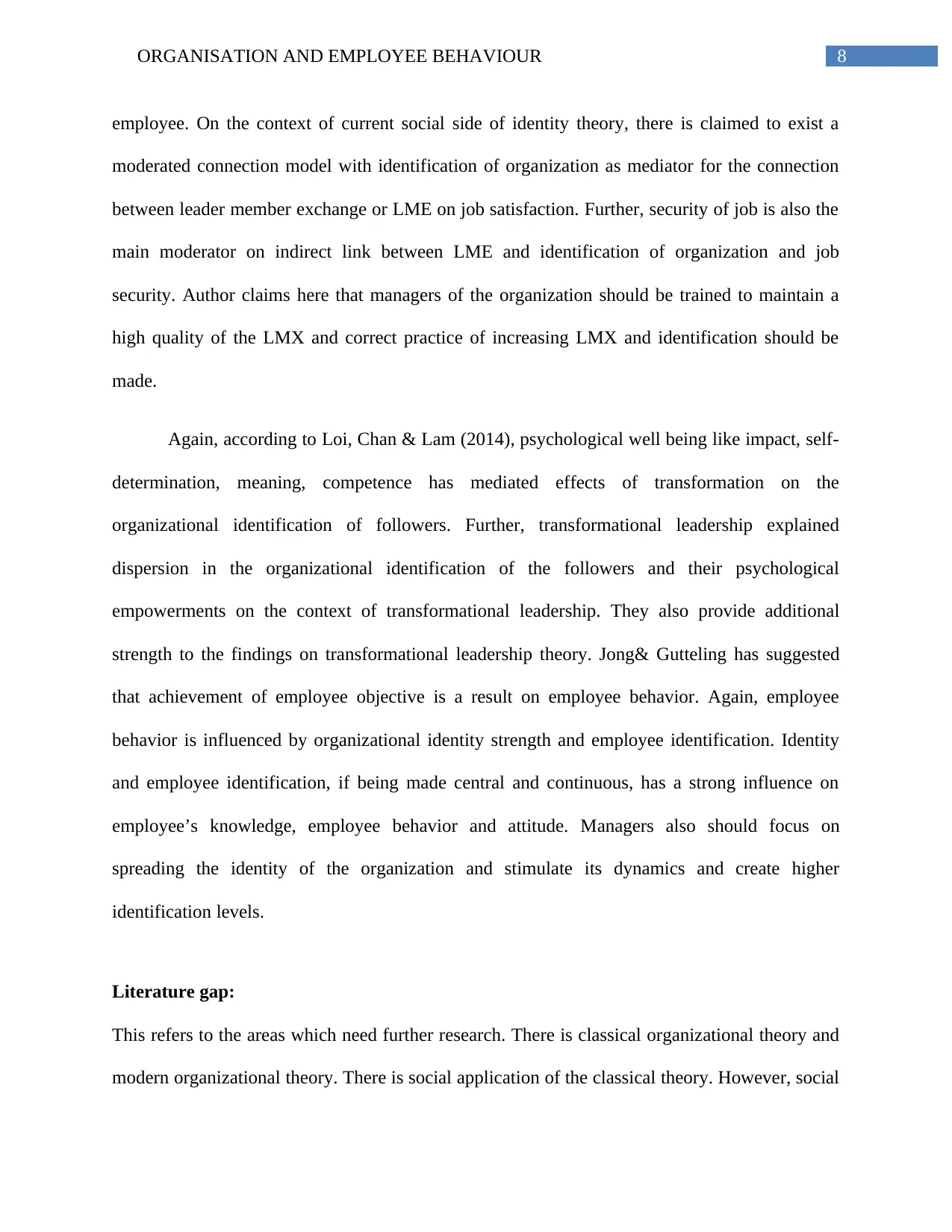
8ORGANISATION AND EMPLOYEE BEHAVIOUR
employee. On the context of current social side of identity theory, there is claimed to exist a
moderated connection model with identification of organization as mediator for the connection
between leader member exchange or LME on job satisfaction. Further, security of job is also the
main moderator on indirect link between LME and identification of organization and job
security. Author claims here that managers of the organization should be trained to maintain a
high quality of the LMX and correct practice of increasing LMX and identification should be
made.
Again, according to Loi, Chan & Lam (2014), psychological well being like impact, self-
determination, meaning, competence has mediated effects of transformation on the
organizational identification of followers. Further, transformational leadership explained
dispersion in the organizational identification of the followers and their psychological
empowerments on the context of transformational leadership. They also provide additional
strength to the findings on transformational leadership theory. Jong& Gutteling has suggested
that achievement of employee objective is a result on employee behavior. Again, employee
behavior is influenced by organizational identity strength and employee identification. Identity
and employee identification, if being made central and continuous, has a strong influence on
employee’s knowledge, employee behavior and attitude. Managers also should focus on
spreading the identity of the organization and stimulate its dynamics and create higher
identification levels.
Literature gap:
This refers to the areas which need further research. There is classical organizational theory and
modern organizational theory. There is social application of the classical theory. However, social
employee. On the context of current social side of identity theory, there is claimed to exist a
moderated connection model with identification of organization as mediator for the connection
between leader member exchange or LME on job satisfaction. Further, security of job is also the
main moderator on indirect link between LME and identification of organization and job
security. Author claims here that managers of the organization should be trained to maintain a
high quality of the LMX and correct practice of increasing LMX and identification should be
made.
Again, according to Loi, Chan & Lam (2014), psychological well being like impact, self-
determination, meaning, competence has mediated effects of transformation on the
organizational identification of followers. Further, transformational leadership explained
dispersion in the organizational identification of the followers and their psychological
empowerments on the context of transformational leadership. They also provide additional
strength to the findings on transformational leadership theory. Jong& Gutteling has suggested
that achievement of employee objective is a result on employee behavior. Again, employee
behavior is influenced by organizational identity strength and employee identification. Identity
and employee identification, if being made central and continuous, has a strong influence on
employee’s knowledge, employee behavior and attitude. Managers also should focus on
spreading the identity of the organization and stimulate its dynamics and create higher
identification levels.
Literature gap:
This refers to the areas which need further research. There is classical organizational theory and
modern organizational theory. There is social application of the classical theory. However, social
⊘ This is a preview!⊘
Do you want full access?
Subscribe today to unlock all pages.

Trusted by 1+ million students worldwide
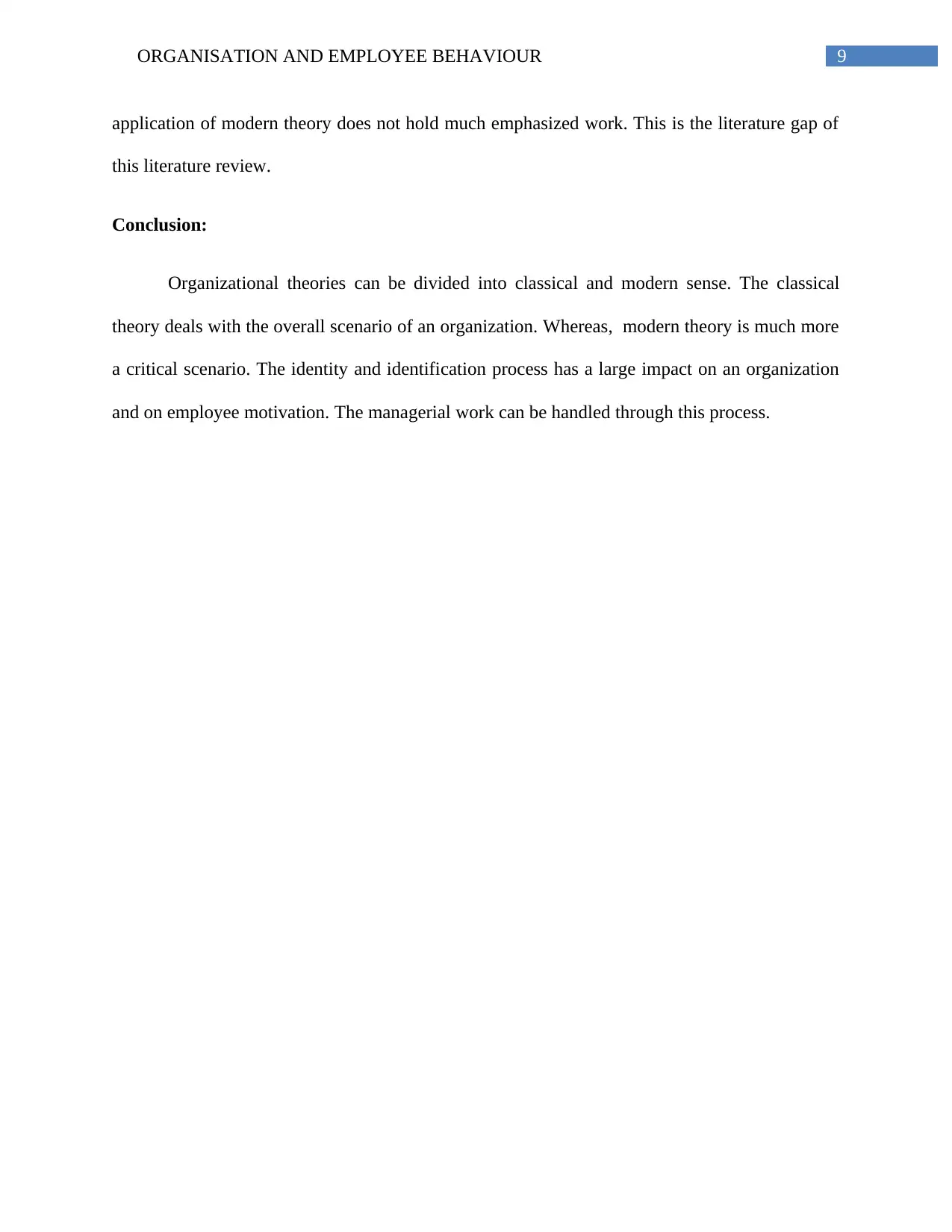
9ORGANISATION AND EMPLOYEE BEHAVIOUR
application of modern theory does not hold much emphasized work. This is the literature gap of
this literature review.
Conclusion:
Organizational theories can be divided into classical and modern sense. The classical
theory deals with the overall scenario of an organization. Whereas, modern theory is much more
a critical scenario. The identity and identification process has a large impact on an organization
and on employee motivation. The managerial work can be handled through this process.
application of modern theory does not hold much emphasized work. This is the literature gap of
this literature review.
Conclusion:
Organizational theories can be divided into classical and modern sense. The classical
theory deals with the overall scenario of an organization. Whereas, modern theory is much more
a critical scenario. The identity and identification process has a large impact on an organization
and on employee motivation. The managerial work can be handled through this process.
Paraphrase This Document
Need a fresh take? Get an instant paraphrase of this document with our AI Paraphraser
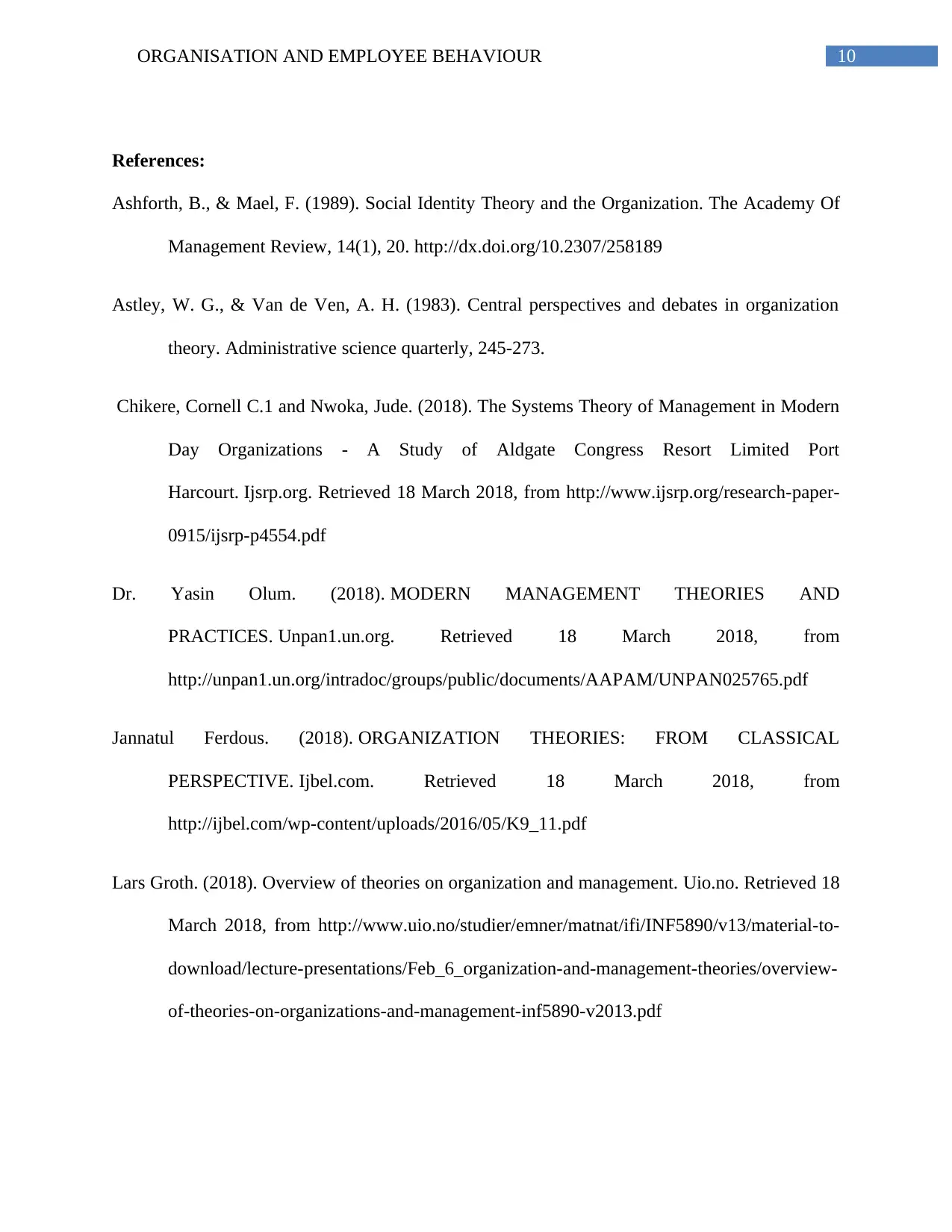
10ORGANISATION AND EMPLOYEE BEHAVIOUR
References:
Ashforth, B., & Mael, F. (1989). Social Identity Theory and the Organization. The Academy Of
Management Review, 14(1), 20. http://dx.doi.org/10.2307/258189
Astley, W. G., & Van de Ven, A. H. (1983). Central perspectives and debates in organization
theory. Administrative science quarterly, 245-273.
Chikere, Cornell C.1 and Nwoka, Jude. (2018). The Systems Theory of Management in Modern
Day Organizations - A Study of Aldgate Congress Resort Limited Port
Harcourt. Ijsrp.org. Retrieved 18 March 2018, from http://www.ijsrp.org/research-paper-
0915/ijsrp-p4554.pdf
Dr. Yasin Olum. (2018). MODERN MANAGEMENT THEORIES AND
PRACTICES. Unpan1.un.org. Retrieved 18 March 2018, from
http://unpan1.un.org/intradoc/groups/public/documents/AAPAM/UNPAN025765.pdf
Jannatul Ferdous. (2018). ORGANIZATION THEORIES: FROM CLASSICAL
PERSPECTIVE. Ijbel.com. Retrieved 18 March 2018, from
http://ijbel.com/wp-content/uploads/2016/05/K9_11.pdf
Lars Groth. (2018). Overview of theories on organization and management. Uio.no. Retrieved 18
March 2018, from http://www.uio.no/studier/emner/matnat/ifi/INF5890/v13/material-to-
download/lecture-presentations/Feb_6_organization-and-management-theories/overview-
of-theories-on-organizations-and-management-inf5890-v2013.pdf
References:
Ashforth, B., & Mael, F. (1989). Social Identity Theory and the Organization. The Academy Of
Management Review, 14(1), 20. http://dx.doi.org/10.2307/258189
Astley, W. G., & Van de Ven, A. H. (1983). Central perspectives and debates in organization
theory. Administrative science quarterly, 245-273.
Chikere, Cornell C.1 and Nwoka, Jude. (2018). The Systems Theory of Management in Modern
Day Organizations - A Study of Aldgate Congress Resort Limited Port
Harcourt. Ijsrp.org. Retrieved 18 March 2018, from http://www.ijsrp.org/research-paper-
0915/ijsrp-p4554.pdf
Dr. Yasin Olum. (2018). MODERN MANAGEMENT THEORIES AND
PRACTICES. Unpan1.un.org. Retrieved 18 March 2018, from
http://unpan1.un.org/intradoc/groups/public/documents/AAPAM/UNPAN025765.pdf
Jannatul Ferdous. (2018). ORGANIZATION THEORIES: FROM CLASSICAL
PERSPECTIVE. Ijbel.com. Retrieved 18 March 2018, from
http://ijbel.com/wp-content/uploads/2016/05/K9_11.pdf
Lars Groth. (2018). Overview of theories on organization and management. Uio.no. Retrieved 18
March 2018, from http://www.uio.no/studier/emner/matnat/ifi/INF5890/v13/material-to-
download/lecture-presentations/Feb_6_organization-and-management-theories/overview-
of-theories-on-organizations-and-management-inf5890-v2013.pdf
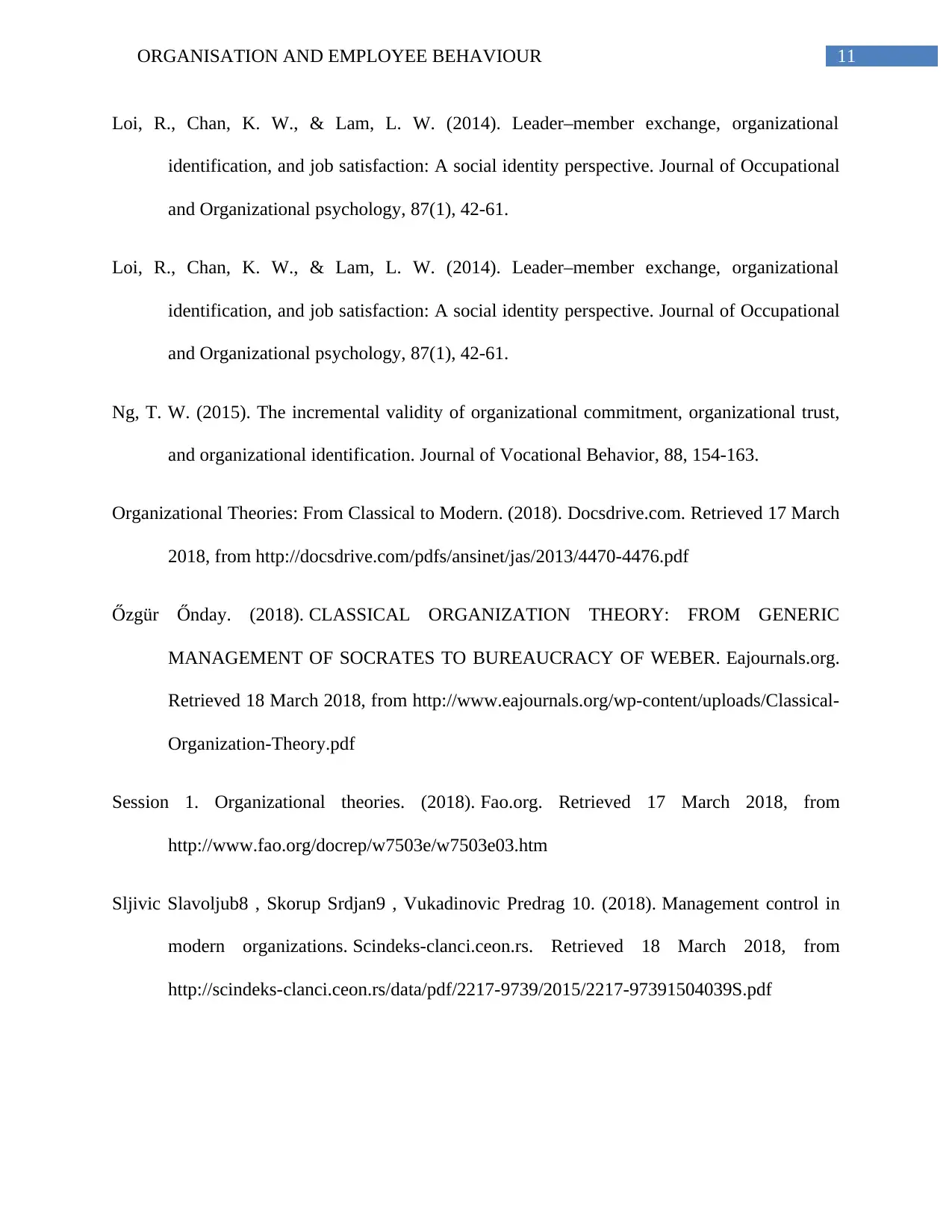
11ORGANISATION AND EMPLOYEE BEHAVIOUR
Loi, R., Chan, K. W., & Lam, L. W. (2014). Leader–member exchange, organizational
identification, and job satisfaction: A social identity perspective. Journal of Occupational
and Organizational psychology, 87(1), 42-61.
Loi, R., Chan, K. W., & Lam, L. W. (2014). Leader–member exchange, organizational
identification, and job satisfaction: A social identity perspective. Journal of Occupational
and Organizational psychology, 87(1), 42-61.
Ng, T. W. (2015). The incremental validity of organizational commitment, organizational trust,
and organizational identification. Journal of Vocational Behavior, 88, 154-163.
Organizational Theories: From Classical to Modern. (2018). Docsdrive.com. Retrieved 17 March
2018, from http://docsdrive.com/pdfs/ansinet/jas/2013/4470-4476.pdf
Őzgür Őnday. (2018). CLASSICAL ORGANIZATION THEORY: FROM GENERIC
MANAGEMENT OF SOCRATES TO BUREAUCRACY OF WEBER. Eajournals.org.
Retrieved 18 March 2018, from http://www.eajournals.org/wp-content/uploads/Classical-
Organization-Theory.pdf
Session 1. Organizational theories. (2018). Fao.org. Retrieved 17 March 2018, from
http://www.fao.org/docrep/w7503e/w7503e03.htm
Sljivic Slavoljub8 , Skorup Srdjan9 , Vukadinovic Predrag 10. (2018). Management control in
modern organizations. Scindeks-clanci.ceon.rs. Retrieved 18 March 2018, from
http://scindeks-clanci.ceon.rs/data/pdf/2217-9739/2015/2217-97391504039S.pdf
Loi, R., Chan, K. W., & Lam, L. W. (2014). Leader–member exchange, organizational
identification, and job satisfaction: A social identity perspective. Journal of Occupational
and Organizational psychology, 87(1), 42-61.
Loi, R., Chan, K. W., & Lam, L. W. (2014). Leader–member exchange, organizational
identification, and job satisfaction: A social identity perspective. Journal of Occupational
and Organizational psychology, 87(1), 42-61.
Ng, T. W. (2015). The incremental validity of organizational commitment, organizational trust,
and organizational identification. Journal of Vocational Behavior, 88, 154-163.
Organizational Theories: From Classical to Modern. (2018). Docsdrive.com. Retrieved 17 March
2018, from http://docsdrive.com/pdfs/ansinet/jas/2013/4470-4476.pdf
Őzgür Őnday. (2018). CLASSICAL ORGANIZATION THEORY: FROM GENERIC
MANAGEMENT OF SOCRATES TO BUREAUCRACY OF WEBER. Eajournals.org.
Retrieved 18 March 2018, from http://www.eajournals.org/wp-content/uploads/Classical-
Organization-Theory.pdf
Session 1. Organizational theories. (2018). Fao.org. Retrieved 17 March 2018, from
http://www.fao.org/docrep/w7503e/w7503e03.htm
Sljivic Slavoljub8 , Skorup Srdjan9 , Vukadinovic Predrag 10. (2018). Management control in
modern organizations. Scindeks-clanci.ceon.rs. Retrieved 18 March 2018, from
http://scindeks-clanci.ceon.rs/data/pdf/2217-9739/2015/2217-97391504039S.pdf
⊘ This is a preview!⊘
Do you want full access?
Subscribe today to unlock all pages.

Trusted by 1+ million students worldwide
1 out of 13
Related Documents
Your All-in-One AI-Powered Toolkit for Academic Success.
+13062052269
info@desklib.com
Available 24*7 on WhatsApp / Email
![[object Object]](/_next/static/media/star-bottom.7253800d.svg)
Unlock your academic potential
Copyright © 2020–2025 A2Z Services. All Rights Reserved. Developed and managed by ZUCOL.





